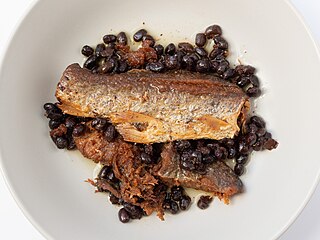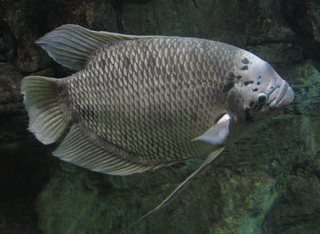
A carp is an oily freshwater fish from various species of the family Cyprinidae, a very large group of fish native to Europe and Asia. While carp is consumed in many parts of the world, they are generally considered an invasive species in parts of Africa, Australia and most of the United States.

The Eurasian carp or European carp, widely known as the common carp, is a widespread freshwater fish of eutrophic waters in lakes and large rivers in Europe and Asia. The native wild populations are considered vulnerable to extinction by the International Union for Conservation of Nature (IUCN), but the species has also been domesticated and introduced into environments worldwide, and is often considered a destructive invasive species, being included in the list of the world's 100 worst invasive species. It gives its name to the carp family, Cyprinidae.
A dace is a small fish that can be one of many different species. The unmodified name is usually a reference to the common dace. This, like most fish called "daces", belongs to the family Cyprinidae, mostly in subfamily Leuciscinae.

A fish pond or fishpond is a controlled pond, small artificial lake or retention basin that is stocked with fish and is used in aquaculture for fish farming, for recreational fishing, or for ornamental purposes.

The rohu, rui, ruhi or roho labeo is a species of fish of the carp family, found in rivers in South Asia. It is a large omnivore and extensively used in aquaculture.

Catla, also known as the major South Asian carp, is an economically important South Asian freshwater fish in the carp family Cyprinidae. It is native to rivers and lakes in northern India, Bangladesh, Myanmar, Nepal, and Pakistan, but has also been introduced elsewhere in South Asia and is commonly farmed.
Agriculture and aquaculture in Hong Kong are considered sunset industries. Most agricultural produce is directly imported from the neighbouring mainland China. In 2006 the industry accounts for less than 0.3% of the labour sector. Geographically Hong Kong consists largely of steep, unproductive hillside. The local aquaculture industry is also facing challenges from competition with imported aquatic food products and concern of fish and seafood safety.

The bighead carp is a species of cyprinid freshwater fish native to East Asia, and is one of several Asian carps introduced into North America. It is one of the most intensively exploited fishes in fish farming, with an annual worldwide production of over three million tonnes in 2013, principally from China. Unlike the omnivorous common carp, bighead carp are primarily filter-feeding algae eaters, preferentially consuming zooplankton but also phytoplankton and detritus.

The flathead grey mullet is an important food fish species in the mullet family Mugilidae. It is found in coastal tropical and subtropical waters worldwide. Its length is typically 30 to 75 centimetres. It is known with numerous English names, including the flathead mullet, striped mullet, black mullet, bully mullet, common mullet, grey mullet, sea mullet and mullet, among others.

The fishing industry in the land-locked country of Laos is a major source of sustenance and food security to its people dwelling near rivers, reservoirs and ponds. Apart from wild capture fisheries, which is a major component of fish production, aquaculture and stocking are significant developments in the country. Historically, fishing activity was recorded in writings on the gate and walls of the Wat Xieng Thong in Luang Prabang dated 1560. For many Laotians, freshwater fish are the principal source of protein. The percentage of people involved in regular fishing activity is very small, only near major rivers or reservoirs, as for most of the fishers it is a part-time activity.

China has one-fifth of the world's population and accounts for one-third of the world's reported fish production as well as two-thirds of the world's reported aquaculture production. It is also a major importer of seafood and the country's seafood market is estimated to grow to a market size worth US$53.5 Billion by 2027.

China, with one-fifth of the world's population, accounts for two-thirds of the world's reported aquaculture production.

Cirrhinus is a genus of fish in the family Cyprinidae, the carps and minnows. Members of this genus are native to freshwater in South Asia, Indochina and southern China.

The mrigal carp, also known as the white carp, is a species of ray-finned fish in the carp family. Native to streams and rivers in India, the only surviving wild population is in the Cauvery River, leading to its IUCN rating as vulnerable. It is widely aquafarmed and introduced populations exist outside its native range. It reaches a maximum length of 1 m (3.3 ft). This species and Cirrhinus mrigala are considered distinct.

The Chinese Academy of Fishery Sciences (CAFS) is a large fisheries research institute. It was founded in 1978 under the Ministry of Agriculture in the People's Republic of China. It is a leading research institution in China, active in almost all research areas to do with aquaculture and marine and freshwater fisheries.

The harvesting and consuming of seafoods are ancient practices that may date back to at least the Upper Paleolithic period which dates to between 50,000 and 10,000 years ago. Isotopic analysis of the skeletal remains of Tianyuan man, a 40,000-year-old modern human from eastern Asia, has shown that he regularly consumed freshwater fish. Archaeology features such as shell middens, discarded fish bones and cave paintings show that sea foods were important for survival and consumed in significant quantities. During this period, most people lived a hunter-gatherer lifestyle and were, of necessity, constantly on the move. However, where there are early examples of permanent settlements such as those at Lepenski Vir, they are almost always associated with fishing as a major source of food.

Fried dace with salted black beans is a canned food of Chinese origin. Cirrhinus molitorella (dace) is a fish from the Pearl River in China. ‘Dace’ is a trade name of Cirrhinus molitorella while ‘salted black beans’ refers to fermented black soybeans known as “dau si” (豆豉) in Cantonese. Fried dace with salted black beans is made by combining dace with salted black beans and preserving it in oil afterwards.

Vishwa Gopal Jhingran (1919–1991) was an Indian zoologist and aquaculture scientist, known for the introduction of a composite fish culture technique by name, aquaplosion. He was a recipient of the fourth highest Indian civilian award of Padma Shri from the Government of India in 1977.

The giant gourami is a species of large gourami native to freshwater habitats in Southeast Asia. It has also been introduced elsewhere. The species is commercially important as a food fish and is also farmed. It can be found in the aquarium trade, as well. The species has been used for weed control on highly invasive aquatic plants like Salvinia molesta, as the giant gourami can be a voracious herbivore.

Mudnakudu Channabasappa Nandeesha was a development researcher, innovative aquaculture development worker and educator. He is recognized for making critical contributions to the rapid growth of aquaculture by applying research to key bottlenecks to fish production. In India, he conducted successful pioneering field tests of Ovaprim, an ovulating agent, under different agro-climatic conditions to help remove a critical early barrier for freshwater fish breeding. His significant scientific contributions include simplified breeding technology for cyprinids and development of feeds and feeding techniques appropriate to rural aquaculture, and helping improve and spread the practices of small scale fish farming at a time when most attention was on large scale producers. He wrote a regular and widely acclaimed column in Network of Aquaculture Centers in Asia-Pacific (NACA) Aquaculture Asia magazine on farmer innovations in aquaculture. He was described as an "ambassador for aquaculture" and was especially noted for promoting aquaculture for the disadvantaged poor households and women. Along with Michael New, in 2003 he was a founding member of the not-for-profit organisation, Aquaculture without Frontiers. While encouraging poor people to take up aquaculture, he was also a pioneer in promoting equity for women, who had been neglected in the aquaculture boom. Throughout his career, he was in the forefront of initiatives to upgrade the professionalism of fisheries and aquaculture experts, and inspired peers and students in critical new directions.



















